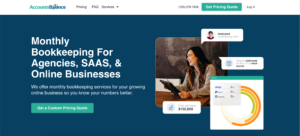
Using a bookkeeping template Google Sheets system for tracking your finances can be a great start. However, templates have limitations, and you may want to graduate from them at a later time.
In this post, we’ll go over how Google Sheets help and what template setup to use. We’ll also talk about some advanced features that free templates will not usually include.
Why Choose Google Sheets for Bookkeeping?
Accessible
Anyone with a free Google account can access basic Google Sheets for free, with no upfront costs or hidden fees. The platform is cloud-based, so you can use your spreadsheets without software, from any device connected to the internet.
Google Sheets is easy to learn, too, and multiple users can work on the same spreadsheet simultaneously, without any costs. If you need more features and storage later on, you can upgrade to Google Workspace plans.
Google takes care of all updates and maintenance for Sheets, and you don’t have to worry about compatibility issues.
Customizable
As the spreadsheet owner, you can control who can view, edit, or comment. This way, your data remains secure while you allow others the necessary level of access to work.
Each user can create their own custom view of the spreadsheet to focus on the information that’s most relevant to their needs. Built-in chat features allow real-time communication within the spreadsheet to streamline workflows.
A bookkeeping template Google Sheets system offers a wide range of other formatting options and functions to tailor spreadsheets to specific requirements.
Key Components of a Bookkeeping Template
The essential categories in a bookkeeping template are composed of:
- Date, to record the date of each transaction
- Description, to describe the transaction
-
Amount, to enter the amount of the transaction
- Alternatively, you can have separate categories for income (positive numbers) and expenses (negative numbers)
- Balance, to automatically calculate your running balance after each transaction
Setting Up Your Bookkeeping Template
Here’s how to create a basic bookkeeping ledger using Google Sheets:
- Create clearly labeled columns at the top of the spreadsheet for the essential categories. Add any other categories specific to your needs.
- Enter your starting balance in the first cell of the “Balance” column. Then, enter the formula to add the cell containing your starting balance to the cells for the first transaction. Apply the formula to the remaining rows.
- Fill in all the columns for each transaction. Check that the balance column automatically updates. If not, check your balance column formula.
- You can format the “Amount,” “Income,” “Expense,” and “Balance” columns to display currency symbols. With conditional formatting, you can also highlight positive (income) and negative (expense) values in the “Amount” column.
- If you have a large volume of transactions, you can create separate sheets for your different categories so the sheet stays neat.
- Don’t forget to reconcile your bank statements regularly to ensure your spreadsheet matches your actual bank balance.
- Update your bookkeeping template Google Sheets system as you go along so it aligns with your needs.

Advanced Features to Enhance Your Bookkeeping
You can seamlessly integrate various Google Workspace tools into your spreadsheet for comprehensive financial management.
Forms
Consider creating a Google Form to collect transaction data from hires, clients, and/or vendors. This this automates the task and reduces manual data entry errors.
Apps Script
Google Apps Script can automate data transfer between forms and your bookkeeping spreadsheet. This ensures real-time updates and fewer errors for more complex workflows.
Data Studio
Connect to your bookkeeping spreadsheet through Google Data Studio and create interactive dashboards and reports. Visualizing your financial data with charts, graphs, and tables allows for easy trend and performance analysis.
Docs and Slides
Export data to Google Docs or Slides to generate financial reports or presentations. This allows you to easily share clear financial information with stakeholders in a professional format.
Gmail
Track and manage invoices and receipts electronically by integrating Gmail with services like DocuSign or eOriginal. Using these services to automatically send relevant information to your bookkeeping spreadsheet streamlines record-keeping.
Templates to Simplify Common Bookkeeping Tasks
Below are some resources where you can find pre-made bookkeeping template Google Sheets for various bookkeeping activities.
Official Google Templates are available directly within the application under the File menu.
Zapier provides various finance-related Google Sheet templates that you can use with their automations.
Smartsheet offers a comprehensive collection of free bookkeeping templates.
Vertex42 offers free and paid Google Sheet add-ons that can enhance your bookkeeping experience.
Choosing the Right Template
Consider the specific needs of your business before selecting a template. Look for templates with the features and functionalities that align with your bookkeeping activities.
We recommend starting with a basic template then gradually adding complexity as your business grows. Keep it simple until you find you need customization.

Troubleshooting Common Issues
A bookkeeping template Google Sheets system offers a great starting point, but it’s not a perfect system.
Limited Functionality
Pre-made templates will not cater to all the specific needs of specific businesses. Free ones will usually lack features or functionalities that are crucial for your bookkeeping processes.
Don’t be afraid to customize a template. Add new columns, sheets, or formulas to accommodate your specific requirements. Explore add-ons from the Google Workspace Marketplace, too, if you need to extend the functionality of your spreadsheet.
Data Inaccuracy
Using Sheets means doing some data entry manually. This means errors can creep in, and we know that Inaccurate data can lead to misleading financial reports.
Use data validation tools to restrict the type of data that users can enter into specific columns. Consider integrating Google Forms to collect transaction data electronically, reducing the chances that these errors will happen.
Formula Errors
Mistakes in adding formulas can lead to incorrect calculations and unreliable data.
Always double-check your formulas to make sure they reference the correct cells. Google Sheets has a formula checker tool that you can use to identify and fix errors.
Security Concerns
If you give spreadsheet users the wrong permissions or share it with the wrong people, they can access sensitive financial data.
Carefully manage sharing permissions to grant access to only those who need it. Clearly define their privileges and the consequences of failure to comply. Use password protection for highly sensitive spreadsheets.
Template Overload
Users can get overwhelmed by too many features in a complex template. Start with a basic template and gradually add complexity as your needs evolve. Focus on what you and your bookkeeper need most and learn to use them effectively before diving into more advanced options.
Frequently Asked Questions
How can I ensure the security of my financial data in Google Sheets?
The first thing to remember about Google Sheets security is that the platform does not offer built-in encryption. You can use password-protected spreadsheet applications or dedicated financial management software if you want something more secure. You can also explore add-ons that encrypt your sheet data at rest and in transit.
Within Google Sheets, here are the steps you can take:
- Don’t store sensitive details like full credit card numbers, social security numbers, or bank account passwords in Sheets.
-
Limit access to who can view and edit your Sheets by making sure that:
- Your Sheets are private.
- You share them with only specific, trusted people, and set the appropriate permission level.
- Restrict access to specific data ranges within your Sheets so users can see some parts of the sheet but not, for example, sensitive financial information.
- Use a strong, unique password, and change it every quarter.
- Use two-factor authentication for your Google account so only someone with access to your phone can gain control.

Can I import data from other accounting software into Google Sheets?
Yes, you can import data from accounting software tools in a few different ways, depending on your needs and the specific tool:
Manual Spreadsheet Import
Most accounting software allows you to export your data in CSV (comma-separated values) format. You can then import this file into Google Sheets. Note that the data formatting might not be perfect, so you need to check for errors.
Direct Integration
Some popular accounting tools, like QuickBooks, offer direct integration with Google Sheets. This allows you to easily import specific data sets directly by connecting your accounts. It’s a lot faster than a manual import and ensures properly formatted data transfers.
Third-Party Add-ons
Several third-party add-ons available for Google Sheets allow you to connect various accounting platforms. Then, you can import data and set up automatic refreshes. In some cases, you can even perform actions within your accounting software from Google Sheets. The best add-ons are not free, though, and may require some setup and configuration.
What are the best practices for backing up financial data in Google Sheets?
Here are some best data backup practices for Google Sheets:
Backup Frequency
Back up financial data daily, if possible. If you don’t update your sheet frequently, weekly backups might be enough.
Backup Methods
Google Sheets automatically saves your sheet as you edit. Make sure version history is enabled so you have the ability to restore a recent version if needed. Export your sheets regularly, as well, so you have a local backup.
You can also create a separate backup sheet within your spreadsheet file to hold historical data snapshots. This way, you can track changes and revert to a specific point if needed. We still recommend saving local copies at least weekly.
Secure Backup Location
Make sure your backups are secure. Don’t just use Google Drive. We recommend a secure local drive with its own secure backup system to prevent data loss. Printing monthly hard copies is also a good idea.

How can I customize a bookkeeping template to fit unique aspects of my business?
You can customize the following aspects of a bookkeeping template to fit your unique business needs:
Chart of Accounts
This foundation of your bookkeeping system categorizes all your income and expenses. Customize the broad categories to reflect your specifics, like “Shipping” or “Social Media Advertising”.
Adding New Sheets
You might need to track more than just income and expenses. You can add sheets for things like “Client Invoices” or “Inventory Management”.
Customizing Formulas
Review any pre-built formulas in your templates and adjust them to match your specific needs. You might also want to add new formulas to calculate different metrics.
Formatting and Filtering
If you’re comfortable with complex spreadsheet functions, you can take advantage of conditional formatting to highlight important information. This is especially important to identify potential issues like when expenses exceed a set threshold or invoices are overdue.
You can also use filters and PivotTables to customize reports and insights so you can analyze your financial data in different ways. By looking at what makes sense to you, you can understand your business performance better.
Are there any advanced Google Sheets functions not covered in the templates that are particularly useful for financial tracking?
We can suggest several advanced Google Sheets functions that can be particularly useful for financial tracking. Note that these functions might have a steeper learning curve.
- With a combination of functions like SUM, VLOOKUP, and IF, you can create scenario models for WHAT-IF analysis. This way, you can see how changes in variables impact your bottom line.
- The Goal Seeking function allows you to work backward from a desired outcome. Specify a target value, and Google Sheets will adjust an input value to achieve that goal based on your formulas. This way, you can set realistic financial goals and see the steps to achieve them.
- The Internal Rate of Return function calculates the profitability of an investment considering a series of cash flows over time. This helps you evaluate capital expenditures or potential opportunities.
- Net Present Value calculates the present value of future cash flows so you can compare different investment option.
- The QUERY Function allows you to extract and manipulate data based on specific criteria. This allows you to create dynamic financial reports.
- The Importrange function takes data from another Google Sheet so you can consolidate financial data for analysis.
- GoogleFinance is a function that allows you to access real-time and historical stock market data directly within your spreadsheet. This way, you can track investment performance, analyze trends, and make informed investment decisions.
What Is AccountsBalance?

AccountsBalance is a monthly bookkeeping service specialized for agencies & SAAS companies.
We take monthly bookkeeping off your plate and deliver you your financial statements by the 15th or 20th of each month.
You’ll have your Profit and Loss Statement, Balance Sheet, and Cash Flow Statement ready for analysis each month so you and your business partners can make better business decisions.
Interested in learning more? Schedule a call with our CEO, Nathan Hirsch.
And here’s some free resources:
In Summary
Make sure you choose the bookkeeping template Google Sheets system that works best for your needs. Every business is different, and you will probably want to make some customizations down the line. As you build on the basics, you’ll know what you want to include, so you should learn how to do it.








